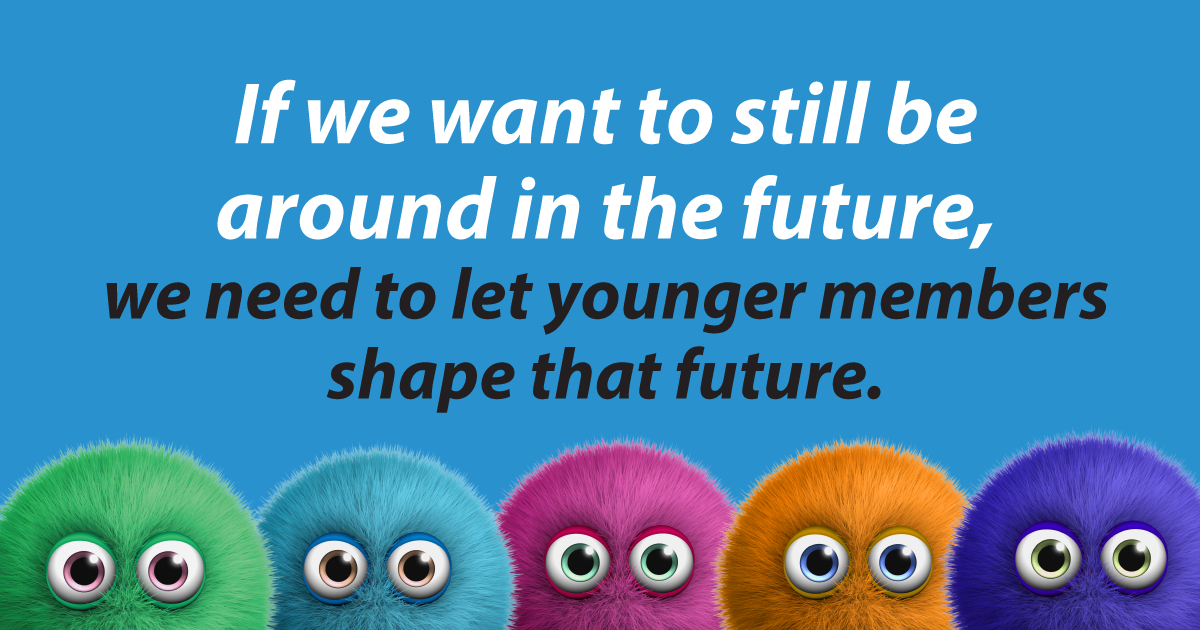
Why you need fewer members who look like me
The median age in the US is 38.5. The average age of a credit union member is 53. That’s already a big gap. But when you realize that 68% of their “most loyal” CU members are older than 65, suddenly that age gap feels even bigger. (No wonder so many credit unions are beginning to see Member Aging as a real problem they need to fix.)
Now, don’t get me wrong. By sharing those statistics, I don’t mean to imply that you should simply get rid of older members.
After all, that’s me in those stats – a grey-haired, 66 year-old (okay, almost 67) Grandpa, who’s been a credit union member since the 80’s, trying to figure out how to ease into retirement (while gracefully turning over the agency to the younger members of our team who are doing most of the work already.)
Have I been a good CU member? Well, at least likely a profitable one, based on the number of accounts and loans from my CU over the years. And my sons are both members of a CU, which in time may mean my grandkids will be as well. But as time goes on, mortgages will be paid off, car loans will become more infrequent, and my profitability will wane.
That’s the real reason why you need fewer members who look like me.
You need more members with a future.
Anyone that has lived to my age realizes that change always happens, whether it happens to you or someone you know. Jobs, marriages, kids, homes, pets, you name it. Nothing stays the same forever, and those twists and turns are what makes life more interesting.
But those twists or turns often involve financial decisions. Whether just starting their journey or in the middle of it, people need a resource they can trust for good advice and financial help.
Picking this college or opting for this trade school. Raising kids or raising your profile at your job. Trading in your old car for a new one or hanging onto it in order to save some money each month to (hopefully) buy a house. Buying a new house or updating the one you have. Saving for your kid’s college or starting a retirement fund.
The possibilities are endless, and can be overwhelming, which is where you come in. You need to provide financial advice and support if you want to help them build their future.
You need more members from all economic levels.
A lot of credit unions grew as the middle class grew in the 1950s-1970s. But the middle class isn’t the big, solid, secure base it once was. Some people are doing just fine, but others are struggling.
Costs for everything are getting higher and higher. Young people are getting priced out of the homeowner market, while watching their rent go up. College loan payments are taking a bite out of their monthly budgets once again.
For many working-class Americans, cars are both a burden and a necessity. They have to have transportation to have a job, and they have to have a job to pay for their transportation. And sometimes that one job doesn’t pay enough so they have to add another job (or two), doubling or tripling their transportation costs. Often they just need a reliable set of wheels to keep providing for their family.
Take a good hard look at your field of membership and start connecting with those that have been left out in the past. You may be amazed at their loyalty, when they are treated as someone with value.
And you need those real-life younger versions of me.
It’s an accepted truth that kids and grandkids usually get accounts where their parents and grandparents bank. Mine did. It was a lot easier to set up an account at my CU for them than it would have been to go somewhere else. And even when both boys moved away from our hometown they kept their accounts there.
But even low-hanging fruit needs to be picked. If you don’t have the products or an ongoing campaign encouraging parents and grandparents to open a savings or college account for their little ones, you need to start.
But you need fewer board members who look like me.
I’m already on two Boards, and many of my fellow Board members are older than me. I mean, I get it. Older people often have the time to volunteer, and they have the experience to keep things running like they have been.
But that’s also part of the problem. If a Board spends all of their time keeping things the same, they aren’t adapting and building for the future.
By increasing the age range and diversity of your Board, you will gain fresh perspectives. By building an atmosphere of innovation, you will encourage new ideas. There are even a few brands out there hiring Gen Z advisory panels in order to get their perspective. Of course, not every CU has the budget or chutzpah to take it that far, but you should at least consider getting outside opinions.
I understand. Change is hard, especially if you look like me. But if you want your credit union to still be around in the future, we need to let younger members shape that future.
- How to “do the right thing” without bragging - July 2, 2024
- Why you should offer “Furry Friend Savings” and “Vetmergency Loans” - May 7, 2024
- It’s hard not to get caught up in a buzz that surrounds you. - April 9, 2024
